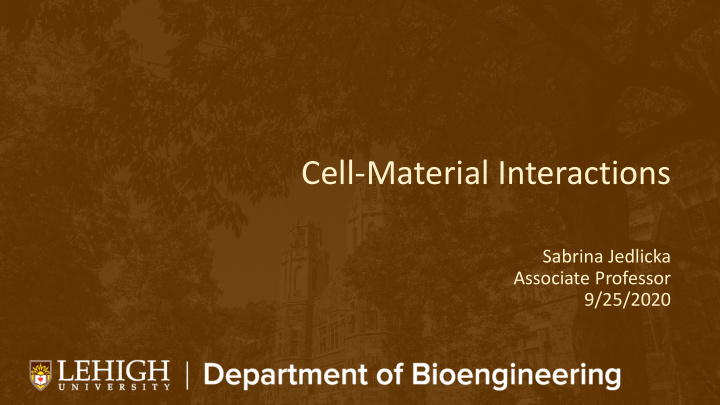



Cell-Material Interactions Sabrina Jedlicka Associate Professor 9/25/2020
Biography • PhD, Purdue University • MS, Biological & Agricultural Engineering, Purdue University • BS, Biological & Agricultural Engineering, Kansas State University Key Publications - T. Sarkhosh (D), X. Zhang, K.L. Jellison, S.S. Jedlicka (2019) “ Calcium-mediated biophysical binding of Cryptosporidium parvum oocysts to surfaces is sensitive to oocyst age .” Applied and Environmental Microbiology, 85(17): e00816-19 - M. Pirbhai (D), S. Chandrasekar (D), Zheng, M. (I), Ignatova, T. (P), Rotkin, S.V., Jedlicka, S.S. (2019) “Augmentation of C17.2 neural stem cell differentiation via uptake of low concentrations of ssDNA-wrapped single-walled carbon nanotubes.” Advanced Biosystems 3(4): 1800321. - T. Ignatova (P), S. Chandrasekar (G), M. Pirbhai (G), S.S. Jedlicka, S.V. Rotkin (2017) “Micro-raman spectroscopy as an enabling tool for long-term intracellular studies of nanomaterials at nanomolar concentration levels.” Journal of Materials Chemistry B, 5(32): 6536-6545 . Keywords – cell-material interactions, nanotechnology, cell differentiation
Nanomaterial/Stem Cell Interactions • What is being studied? • How do insignificant concentrations of carbon nanomaterials influence neural stem cell differentiation? • Why is the topic significant? • The uptake mechanisms and downstream interactions of nanomaterial uptake have been shown to increase differentiation yield by 10 fold • Nanomaterials have significant drug delivery and regenerative medicine potential • How do we study it? • Confocal Raman Microscopy/Spectroscopy • Biomolecular Analysis • Future Directions • Identification of differentiation pathway disruption • Pathway modeling & targeting
Waterborne Pathogens • What is being studied? • Cryptosporidium fate, transport, and detection in environmental and physiological systems • Why is the topic significant? • Cryptosporidium is not removed by traditional water treatment methods, and can cause severe gastrointestinal disease. • The biophysical characteristics of the pathogen are not well understood and could yield insight into therapies and rapid/cheap detection methods. • How do we study it? • Force Spectroscopy, Electron & Confocal Microscopy • Biomimicry of environmental and physiological systems • Future Directions • Development of cheap/rapid detection method • Development of a physiologically relevant infection model
Stem Cell Derived Therapeutics • What is being studied? • Human Mesenchymal Stem Cells – patient variability • Human Mesenchymal Stem Cells – potential production of exosomes • Why is the topic significant? • MSC therapies are being offered in clinics across the nation as autologous transplants. System to system variability is significant, and patient outlook is positive, but not without risk. • How do we study it? • Biomolecular Analysis • Variable Culture Conditions • Microscopy • Future Directions • Development of a high-yield production platform for ”designed” exosomes • Development of rapid diagnostic to indicate likely patient outcome
Contact Sabrina Jedlicka ssj207@lehigh.edu See: https://jedlickalab.wordpress.com/page/ https://engineering.lehigh.edu/faculty/sabrina-jedlicka
Recommend
More recommend